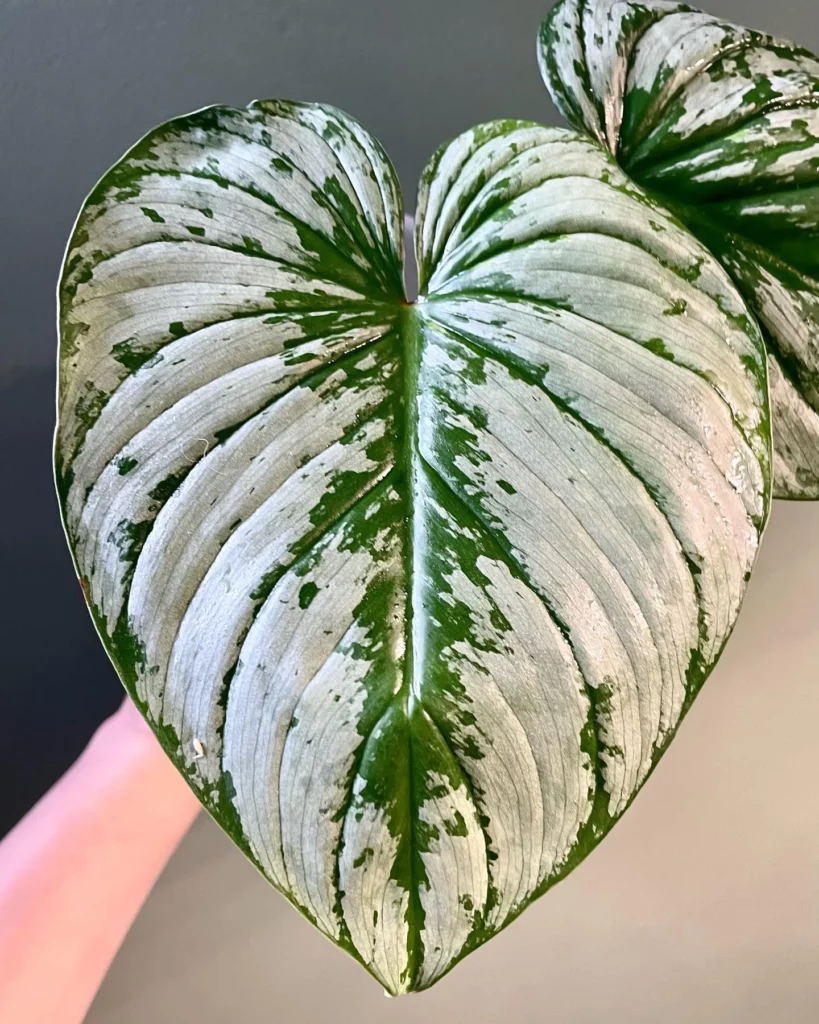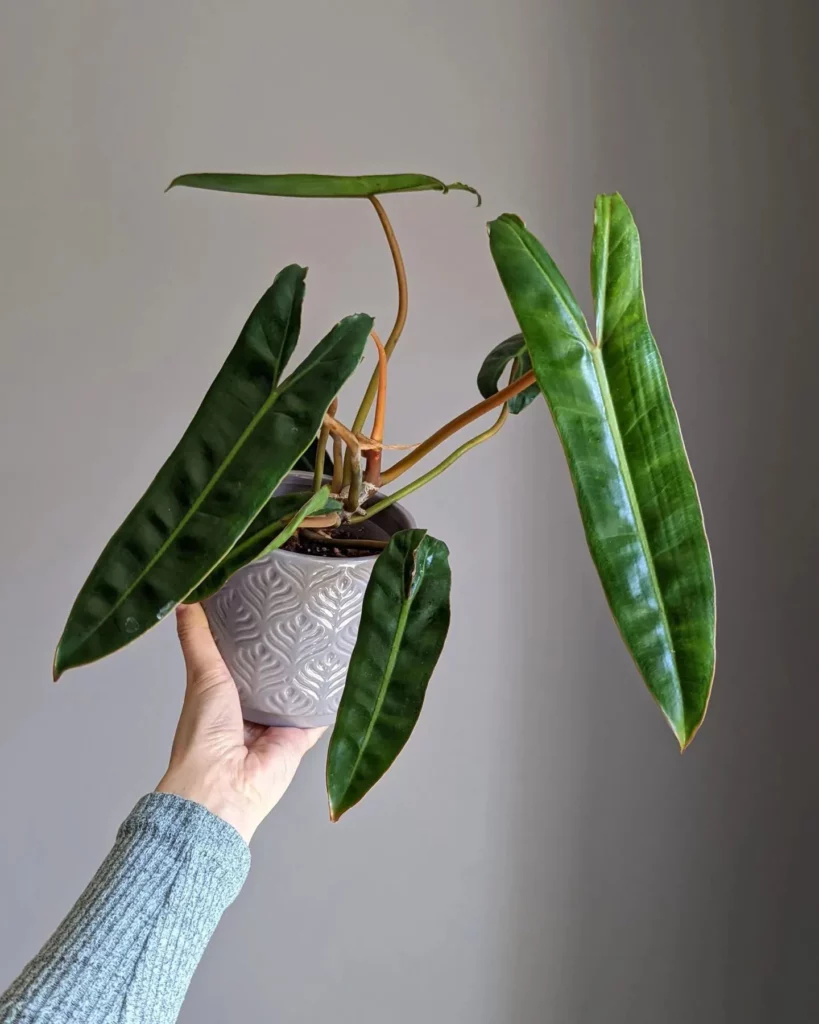Welcome to your comprehensive care guide for the stunning Philodendron Mamei. With its large, heart-shaped foliage (with silver streaks and deep veins) this rare beauty is sure to make a statement in your indoor tropical jungle. You will find all the information you need to successfully care for your Philodendron Mamei in this article.
Appearance of Philodendron Mamei



The Philodendron Mamei is a stunning houseplant that catches the eye with its unique appearance. Its foliage is one of its most striking features, with large, heart-shaped leaves that command attention. The leaves have beautiful silver streaks and deep veins, creating an intricate pattern that adds to the plant’s allure.
The variegation on the foliage gives the Philodendron Mamei a distinctive look, making it a popular choice among plant enthusiasts looking for something unique to enhance their indoor spaces.
Key Features of Philodendron Mamei:
- Large, heart-shaped leaves
- Variegated foliage with silver streaks and deep veins
- Climbing and trailing growth habit
No products found.
How to Grow a Philodendron Mamei



Growing a Philodendron Mamei is an exciting endeavor that requires attention to specific care requirements. By following these tips for growing your Philodendron Mamei, you can ensure that it thrives and becomes a beautiful addition to your indoor tropical jungle.
Light Requirements
- Place your Philodendron Mamei in bright but indirect light to mimic its natural habitat. An east or west-facing window is ideal, but if you only have a bright south-facing aspect, use a sheer curtain to filter the light.
- Rotate the plant regularly to promote even growth and prevent any potential damage from direct sunlight.
Soil Requirements
- Ensure your Philodendron Mamei is planted in loose and well-draining soil. Ready-made aroid potting mixes or a mix of orchid bark, perlite, and peaty soil are suitable choices.
- Avoid clumpy soil that can become waterlogged and lead to root rot. The soil should strike a balance between good drainage and moisture retention.
Watering and Humidity
- Water your Philodendron Mamei when the top 2 inches of the potting mix are dry. This plant prefers slightly drying out between waterings.
- Philodendron Mamei appreciates high humidity levels, so consider using a humidifier or placing the plant in a bathroom to create a steamy environment.
Fertilizing
- Sparingly fertilize your Philodendron Mamei during the growing season using a balanced houseplant fertilizer. Follow the instructions on the packaging for the correct dosage.
- Regular pruning of dead or dying leaves will help redirect energy to healthy new growth, ensuring a thriving and lush Philodendron Mamei.
Propagation Tips



If you’re looking to expand your Philodendron Mamei collection or share this beautiful plant with friends, propagation is a simple and rewarding method. The most common and successful way to propagate Philodendron Mamei is through stem cuttings. Here’s a step-by-step guide on how to propagate your Philodendron Mamei:
1. Selecting a Healthy Stem Cutting
Choose a healthy stem from your Philodendron Mamei that has at least four leaves. The stem should be around 6 inches long and have a healthy node at the base. Nodes are where new roots will form, so it’s crucial to have at least one on your cutting.
2. Preparing the Cutting
Remove the bottom leaves from your chosen stem cutting, leaving two or three leaves at the top. This helps reduce water loss and allows the cutting to focus its energy on root development. Make sure to use clean, sharp shears or a knife to avoid damaging the cutting or introducing any potential infections.
3. Propagating in Water or Soil
You have two options for propagating your Philodendron Mamei: in water or in well-draining soil. If you choose water propagation, place the cutting in a glass or jar filled with water, making sure only the stem is submerged. Alternatively, you can insert the cutting directly into a well-draining potting mix, ensuring the node is buried and the leaves are above the soil line.
After a few weeks, your Philodendron Mamei cutting should develop roots that are around 1 inch long. Once the roots have reached this length or if the cutting stays put in the soil when gently tugged, it’s time to repot the cutting into its own container and care for it as a mature plant.
Light Requirements


When it comes to fulfilling the light needs of your Philodendron Mamei, it’s important to mimic the dappled light it receives in its natural rainforest habitat. This plant thrives in bright but indirect light, avoiding direct sunlight that can scorch its delicate foliage. To provide the perfect light conditions, consider placing your Philodendron Mamei near an east or west-facing window. If the only available spot is a bright south-facing aspect, you can filter the light with a sheer curtain to create the ideal environment for your plant to thrive.
Positioning Your Philodendron Mamei
- Place your Philodendron Mamei near an east or west-facing window to ensure it receives bright but indirect light.
- If the only available location is a bright south-facing window, use a sheer curtain to filter the light and protect the plant from direct sunlight.
- Rotate your plant regularly to promote even growth and prevent any damage from light being focused on one side.
Soil Requirements
The Philodendron Mamei thrives in loose and well-draining soil. To provide the optimal growing medium for your plant, you have a few options:
- Create your own soil mix by combining equal parts orchid bark, perlite, and peaty soil. This blend will provide good drainage while retaining enough moisture for the plant’s needs.
- Alternatively, you can use a ready-made aroid potting mix, which is specifically formulated for tropical plants like the Philodendron Mamei.
It’s important to avoid using clumpy soil that can become waterlogged and potentially cause root rot. To maximize drainage, you can add a small amount of gravel to the soil mix.
Pruning and Shaping


Pruning is an essential aspect of maintaining the health and appearance of your Philodendron Mamei. By removing dead or dying leaves, you allow the plant to direct its energy towards new growth, resulting in a lush and vibrant plant. Regular pruning will also help maintain a compact and bushy habit, giving your Philodendron Mamei a more aesthetically pleasing shape.
When to Prune
- The optimal time to prune your Philodendron Mamei is during the spring or summer when the plant is actively growing. This is when it has the highest potential for new foliage growth.
- Avoid pruning during the fall and winter months as the plant’s growth slows down, and it may have difficulty recovering from the pruning process.
- Always use clean and sharp pruning tools to minimize any damage to the plant.




